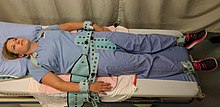User:Mr. Ibrahem/Excited delirium
| Mr. Ibrahem/Excited delirium | |
|---|---|
| Other names | Excited delirium syndrome, agitated delirium |
 | |
| An example of physical restraints which may be used until chemical sedation takes effect. | |
| Specialty | Emergency medicine, psychiatry |
| Symptoms | Agitation, delirium, sweating[1] |
| Complications | Rhabdomyolysis, high blood potassium[1] |
| Causes | Drug use, mental illness[1] |
| Differential diagnosis | Low blood sugar, heat stroke, thyrotoxicosis, paranoid schizophrenia, bipolar disorder[1] |
| Treatment | Sedation, cooling, intravenous fluids[1] |
| Medication | Ketamine or midazolam and haloperidol[2] |
| Prognosis | Risk of death < 10%[1] |
| Frequency | Unknown[1] |
Excited delirium, also known as agitated delirium, is a condition that presents with psychomotor agitation, delirium, and sweating.[1] It may include attempts at violence, unexpected strength, and very high body temperature.[3] Complications may include muscle breakdown or high blood potassium.[1]
The cause is often related to long term drug use or mental illness.[1] Commonly involved drugs include cocaine, methamphetamine, or certain substituted cathinones.[3] In those with mental illness, rapidly stopping medications such as antipsychotics may trigger the condition.[1] The underlying mechanism is believed to involve dysfunction of the dopamine system in the brain.[3] The diagnosis is recognized by the American College of Emergency Physicians but is not in the Diagnostic and Statistical Manual of Mental Disorders or the International Classification of Diseases.[1][4]
Treatment initially includes medications to sedate the person such as ketamine or midazolam and haloperidol injected into a muscle.[2] Rapid cooling may be required in those with high body temperature.[1] Other supportive measures such as intravenous fluids and sodium bicarbonate may be useful.[1] The risk of death among those affected is less than 10%.[1] If death occurs it is typically sudden and cardiac in nature.[1]
How frequently cases occur is unknown.[1] Males are affected more often than females.[5] Those who die from the condition are typically male with an average age of 36.[1] Often law enforcement has used tasers or physical measures in these cases.[1] A similar condition was described in the 1800s and was referred to as "Bell's mania".[1] The term "excited delirium" did not come into use until the 1980s.[1]
References[edit]
- ^ a b c d e f g h i j k l m n o p q r s t u Vilke, GM; DeBard, ML; Chan, TC; Ho, JD; Dawes, DM; Hall, C; Curtis, MD; Costello, MW; Mash, DC; Coffman, SR; McMullen, MJ; Metzger, JC; Roberts, JR; Sztajnkrcer, MD; Henderson, SO; Adler, J; Czarnecki, F; Heck, J; Bozeman, WP (November 2012). "Excited Delirium Syndrome (ExDS): defining based on a review of the literature". The Journal of Emergency Medicine. 43 (5): 897–905. doi:10.1016/j.jemermed.2011.02.017. PMID 21440403.
- ^ a b Gerold, KB; Gibbons, ME; Fisette RE, Jr; Alves, D (2015). "Review, clinical update, and practice guidelines for excited delirium syndrome". Journal of Special Operations Medicine. 15 (1): 62–9. PMID 25770800.
- ^ a b c Mash, DC (2016). "Excited Delirium and Sudden Death: A Syndromal Disorder at the Extreme End of the Neuropsychiatric Continuum". Frontiers in Physiology. 7: 435. doi:10.3389/fphys.2016.00435. PMC 5061757. PMID 27790150.
{{cite journal}}: CS1 maint: unflagged free DOI (link) - ^ Vilke, Gary M.; Payne-James, J. Jason (2016). Current Practice in Forensic Medicine. John Wiley & Sons, Ltd. pp. 97–117. doi:10.1002/9781118456026.ch6. ISBN 9781118456026.
- ^ Gonin, P; Beysard, N; Yersin, B; Carron, PN (May 2018). "Excited Delirium: A Systematic Review". Academic Emergency Medicine. 25 (5): 552–565. doi:10.1111/acem.13330. PMID 28990246.
